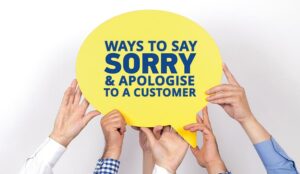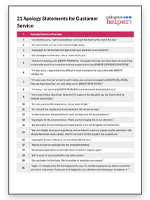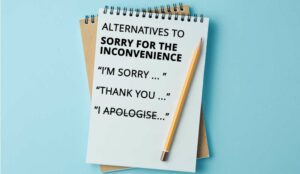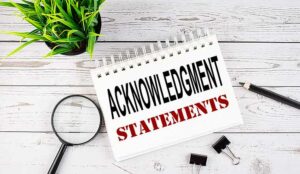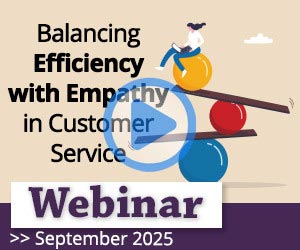Apologizing to a customer the right way can turn a negative experience into a positive one, strengthening relationships and building long-term loyalty.
A well-crafted apology goes beyond just saying ‘I’m sorry’ – it acknowledges the issue, takes responsibility, and reassures the customer that steps are being taken to prevent future problems.
That’s why we have put together 21 effective ways to express an apology, along with real life statement examples your call centre team can use to rebuild trust and improve customer satisfaction.
Why You Should Apologize to Customers
When customers encounter issues or negative experiences, a sincere apology can make all the difference.
Here are 5 reasons why apologizing to customers is crucial:
- Reduces conflict and diffuses anger
- Demonstrates care and empathy
- Builds trust and credibility
- Retains customers and reduces churn
- Encourages feedback and improvement
21 Examples of Apology Statements for Customer Service
There are many apologetic synonyms your agents can use in the contact centre. Here are some short apologetic messages and examples of sincere apologies for customers to help give agents more guidance on how to say sorry to a customer:
High Empathy and Immediate Resolution Focus
- “I am terribly sorry, I will try everything I can to get this fixed by the end of the day.”
- “I’m sorry for the mix-up. Let’s correct it right away.”
- “I apologize for the mistake and appreciate your patience as we resolve it.”
- “Our apologies for the error. Let us correct it for you.”
- “Thanks for alerting us to [INSERT PROBLEM]. I recognize that this can’t have been an easy thing to deal with and I’m so sorry that we have caused you to feel [INSERT EXPRESSED EMOTION].”
- “I’m very sorry, I appreciate how difficult it must have been for you to deal with [INSERT PROBLEM].”
- “I’m very sorry that you’ve had to call in today, but we have managed to [INSERT SOLUTION]. Now we have done that, our next steps are to [INSERT NEXT STEPS].”
- “I’m sorry, I can see how [INSERT PROBLEM] must have been frustrating for you.”
Acknowledgment and Commitment to Resolve
- “I am sorry to hear about that. Now that I’m aware of the situation, we can look to fix it by [INSERT SOLUTION].”
- “I’m sorry you had this experience. Let us make it right.”
- “I’m sorry for the trouble you’ve encountered. We’re here to help.”
Recognition of Customer’s Feelings
- “I understand your disappointment, and I apologize for the inconvenience.”
- “I apologize for the inconvenience. Thank you for bringing this to our attention.”
- “We apologize for not meeting your expectations. Let’s work together to resolve this.”
- “We care deeply about your experience and we failed to meet our regular quality standards. We should have been more careful, and I’m very sorry for the issues it has caused you.”
General Apologies and Clarifications
- “I apologize for any confusion. Let me clarify that for you.”
- “Please accept our apologies for the misunderstanding.”
- “We deeply regret the error and will ensure it doesn’t happen again.”
- “We’re sorry for any trouble this may have caused.”
Apologies for Specific Issues
- “Our apologies for the delay. We’re working to expedite your request.”
- “Again, I’m deeply sorry this has happened to you. It’s not the experience we wish to create for any of our customers. Thank you for bringing it to our attention and allowing us to address it.”
Printable – 21 Examples of Apology Statements for Customer Service
Do you want to download this to share with your team?
Get your free download of 21 Apology Statements for Customer Service now:
How to Apologize to a Customer – Tips, Tricks and Examples on Using Apology Statements in Customer Service
If you’re looking for an effective apology for customers, here we take you through the key stages of saying “I am sorry” in the contact centre – with relevant, contextual examples of how to use customer service apology statements in a sentence.
Give Your Full Name
Ownership should be taken before the apology is made, as part of the initial greeting. One quick way to do this is for agents to give customers their full name, as this subconsciously gives the customer a signal that ‘they’ve given me their name, so they’re going to look after me – they’re going to take ownership for this’.
As Stuart Harris, a customer service speaker and coach, comments:

“I coach a technique called ‘the double hand-shake’ where, after an agent’s greeting, they say: ‘In case you missed my name at the start of the call, I’m John Smith (for example) and I’m here to look after you today’.
The customer will, in most cases, instinctively say ‘Hi John’ before continuing with the conversation.
We all know that using the customer’s name is a big rapport builder, but if we can interact with the customer on a first name basis, we are really strengthening that bond – making the apology that comes after much more personal.”
For more guidance on how best to open a customer service call, read our article: The Best Customer Service Greeting Phrases – With Examples
Listen Well and Ask the Right Probing Questions
For authenticity, agents must be sure what they are apologizing to the customer for. This also benefits the agent, as they can personalize the apology, to increase the sincerity.
It’s therefore key to listen well and ask the right probing questions. By doing this, the agent can assess and clarify the situation to ensure that everyone is on the same page, while seeming attentive and genuine.
You can use the TED principle to help set up probing questions. TED stands for Tell, Explain and Describe.
Statements that are used as part of the TED questionning technique include:
- “Tell me, has this happened before?”
- “Explain to me, what impact has this had on your…?”
- “Describe how you felt about that…”
You can find out more about the TED technique here: 15 TED Questions for Customer Service – With Examples
Avoid Assumptions
When handling a sorry call, many agents make assumptions based on previous experiences with customers who have had a similar issue.
These assumptions are the enemy of a good apology and often lead to agents reaching conclusions that are not in the best interest of the individual customer, according to Stuart Harris.
As Stuart says: “Agents often make assumptions about what the customer is talking about, because they have heard it a dozen times before.
“Sometimes to save the customer’s time and sometimes to reduce their Average Handling Time (AHT), the agent will jump in with what they perceive to be the solution, believing it to be in the customer’s best interest. But, generally, it is not.
“In my time as a training & quality assurance manager, we recognized that most angry and frustrated customers just wanted to get that feeling off their chest. They wanted to vent. By jumping straight to the solution and not hearing them out, the agent is taking that away from them.
“The first step is to let the customer vent, which also will allow the agent (through listening and probing questions) to find out what the full extent of the problem is, which adds authenticity to your apology.”
Say Sorry in a Professional Way
When shaping your core messages for a customer service apology, it’s important to remember that an authentic apology requires two key elements; empathy and personalization – as explained in more detail below:
Empathy
Showing empathy helps to demonstrate a mutual understanding and create trust, meaning that it has an important role to play in an apology.
As Stuart Harris says: “Put yourself in the customer’s shoes and understand where that frustration is coming from. Customers just want to feel as though they have been heard.
“They want to feel as if the person that they are speaking to understands what the problem is and they want someone to apologize genuinely.”
Empathy also helps to legitimize the customer’s feelings. If they feel appreciated, it makes it much easier to turn around a tricky situation.
For examples of empathy statements, read our article: Empathy Statements for Customer Service
Personalization
A general principle of rapport building is to use the language that the customer uses, and this is also a good practice when apologizing to a customer – which is why it is important to assess and clarify the customer’s issue before offering your apology.
By reflecting back on the customer’s issue in your apology and using their language, you demonstrate a mutual understanding and that you have listened to their issue thoroughly.
Stuart calls these snippets of the customer’s speech that you repeat back to them “conversational offers” as they add depth to your apology.
Stuart says: “‘Conversational offers’ are also used to refer to any interesting information that a customer gives to you, which gives you something to fall back on when there is dead air.”
Examples of Empathy and Personalization
Here are a few examples that show how empathy and personalization can be fused together to form an customer service apology phrase. These can be customized to different situations.
- I’m sorry, I can see how [INSERT PROBLEM] must have been frustrating for you.
- I’m very sorry, I appreciate how difficult it must have been for you to deal with [INSERT PROBLEM]
- I understand how [issue] must have impacted your [workflows etc.]
- Thanks for alerting us to [INSERT PROBLEM]. I recognize that this can’t have been an easy thing to deal with and I’m so sorry that we have caused you to feel [INSERT EXPRESSED EMOTION]
Solve the Problem
It’s not enough for agents to just say “I’m sorry”. Train them to take positive steps to show they are sorry by solving the problem and making things right again. Where applicable, they should also show that they are taking steps to prevent a recurrence of the problem.
Apology statement examples to try:
- “The issue happened because we [INSERT WHAT CAUSED THE ISSUE]. To prevent it from happening again I [INSERT WHAT YOU WILL DO].”
- “We care deeply about your experience and we failed to meet our regular quality standards. We should have been more careful, and I’m very sorry for the issues it has caused you, so I will [INSERT WHAT YOU WILL DO] to get this fixed for you.”
Create a Sense Immediacy
It is important to next remove all uncertainty and indicate that you are striving to resolve the customer’s issue in a timely manner. This creates the notion that you are on the customer’s side, strengthening rapport.
To reassure the customer of this, it is important to use active verbs to assure them that you are already actively working on solving their query. For example say: “I will resolve this for you before Friday” instead of “This will be resolved before Friday.”
Taking all this into account, here are some reassuring statements that also help to provide a sense of immediacy, which will ideally be used alongside your apology.
- “What I’m now doing to help you is [INSERT ACTION].”
- “You were absolutely right to bring this to my attention, so I can immediately [INSERT ACTION]”
- “As I investigate, I can see that…”
TOP TIP: Keep your promises! If you give promises to customers – such as time expectations – make sure that you can keep them. This will help you to avoid aggravating an already disappointed customer.
Take Ownership
By taking ownership of the situation and making a commitment to the customer, you can begin to rebuild trust.
Statements that establish ownership and show commitment include:
- “I will try everything I can to get this fixed by the end of the day.”
- “I will contact you as soon as I have an update.”
- “I will work on resolving the problem and I will be in touch shortly, so you can carry on with your day and rest assured it’s being taken care of.”
Demonstrate Cooperation in Giving a Solution
Now you’ve given your apology, reassured the customer and taken ownership of the call, it’s time to focus on turning the negative situation into a positive and finding the solution.
The focus so far has very much been on using “I” as the agent and apologizing to “you” as the customer. But now it’s time to bring in the “we” when looking for a solution, according Stuart Harris.
As Stuart says: “Go from the ‘I to the you to the we’, as in ‘what do I need from you so that we can resolve this problem together’. We want to signal that this is a joint-fix instead of it all being ‘me, me, me’, as this helps to build a much stronger relationship.”
With this in mind, let’s take a look at a couple of interesting examples of how to present solutions to customers and turn negatives into positives.
- “This situation is difficult, but one solution that we could try is to [INSERT SOLUTION].”
- “Now that I’m aware of the situation, we can look to fix it by [INSERT SOLUTION].”
- “If I were in your situation, I would feel the same. What I would try, and I suggest that we do too, is to [INSERT SOLUTION].”
TOP TIP – Focus on the solution! Once the agent takes steps to resolve the issue in hand, this is where their emphasis should stay. They shouldn’t keep referring back to the problem and reminding the customer of the negative. This helps to keep the interaction upbeat.
Closing the Apology
At the end of the call, agents should wrap up by summarizing the solution (not the original problem) to remind the customer what’s been achieved. They should also provide any much-needed details about next steps to avoid an unnecessary callback.
TOP TIP: Agents should try not to say “sorry” too often during the call, as it may decrease the value of your original apology.
Here is a statement that you could consider using to “close the apology”.
“I’m sorry that you’ve had to call in today, but we have managed to [INSERT SOLUTION]. Now we have done that, our next steps are [INSERT NEXT STEPS].”
For examples of courteous call-closing phrases, read our article: The Best Call-Closing Statements
Say Thank You
Another way to end your apology is to thank the customer and end the call on a positive note.
After all, the customer has taken time out of their day to make the call and patiently (in most cases) wait while it’s revolved.
By saying thank you, you show the customer that you appreciate this, and start to return the relationship to a positive equilibrium.
Here are some more apology statement examples to try:
- “Again, I’m deeply sorry this has happened to you. It’s not the experience we wish to create for any of our customers. Thank you for bringing it to our attention and allowing us to address it.”
- “Thank you for bearing with us through this incident. If there’s anything else I can help you with, please let me know.”
How NOT to Apologize to a Customer
There are many mistakes that agents often make when apologizing to customers, which only serve to escalate the problem further.
While the apology statements above will help you to avoid these pitfalls, it’s important that you are conscious that you don’t do any of the following…
Don’t say: “Sorry for ANY inconvenience” / “I’m sorry IF you FEEL THAT WAY”
Using words/phrases like “any”, “if” and “feel that way” cast doubt on any feelings that the customer may have expressed previously, taking sentiment away from the apology.
Don’t say: “We’re sorry”
Using “we”, as in the agent and the company, doesn’t transmit to the customer that you are personally interested in them.
An apology should use pronouns such as “I” and “you” to indicate to the customer that you are on their side.
Using “we”, as in the agent and the company, doesn’t transmit to the customer that you are personally interested in them.
Don’t use overly formal language
You do not want your agents to sound robotic when saying sorry.
Train your agents to simply say “I’m sorry” using contractions to bring a more relaxed tone to the conversation – instead of the more formal, non-contracted “I am sorry”.
Also steer away from elaborate phrases such as “I profoundly express my regret” to help apologies sound more authentic.
Don’t say: “But…”
It’s all very well your agents saying “I’m sorry”. However, if what follows next is the word “but…”, it makes the apology seem more of an excuse than a genuine apology.
Make your agents aware of the damage this small but powerful word can cause, as this typically signals to the customer they aren’t interested in helping them or taking responsibility.
For more language tips for your contact centre agents, read our articles:
- Customer Service Apologies – Keeping Sorry Fresh and Sincere
- Top 25 Positive Words, Phrases and Empathy Statements
- Positive Customer Service Language for Positive Conversations
- “Sorry for the Inconvenience” – How to Offer a Genuine Apology
Author: Jonty Pearce
Reviewed by: Robyn Coppell
Published On: 22nd Sep 2023 - Last modified: 14th Aug 2025
Read more about - Skills, Apologies, Customer Service, Editor's Picks, Empathy, Free Downloads, Language, Listening, Skill Development





